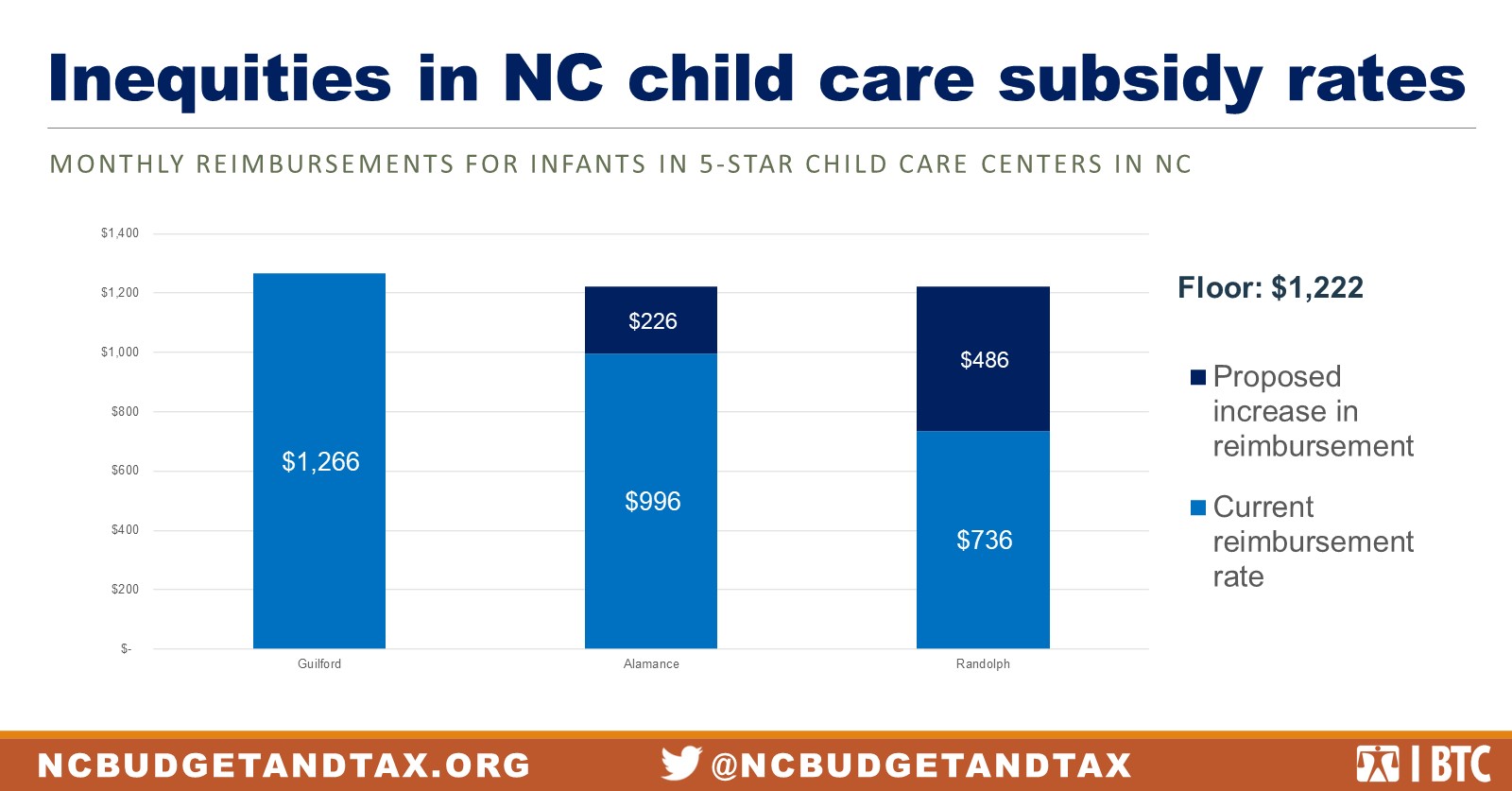House Bill 574 increases the reimbursement rates for child-care providers that care for children who receive child-care assistance, helping to stabilize providers and ensuring every community can meet the need for quality child care for working families during North Carolina’s recovery from COVID-19.
HB 574 would:
- Set new subsidy rates at the county level based on the most recent survey of provider rates
- Establish a new “statewide floor” based on the statewide rates in the most recent survey
- Eliminate the restriction that subsidy rates cannot be higher than private fee-paying rates
- Eliminate the 20-month time limit on receiving child-care subsidies for people in post-secondary education
- Appropriate a total of $146 million over the biennium for these changes
A strong and stable child-care system is essential to North Carolina’s recovery from COVID-19. Child-care providers are small businesses who are anchors in their community and employ educators who do the vital work of caring for the youngest North Carolinians. Working parents returning to jobs need to have accessible, affordable high-quality education opportunities for their children. Children need the stability and high-quality environments that support their healthy development.
Providers need a boost now. The current system for reimbursing providers for delivering high quality care isn’t working.
Child-care providers operate their businesses on thin margins because they rely primarily on parents’ ability to pay fees, along with reimbursements for providing early childhood education for children who receive child-care assistance. With child-care costs increasingly out of reach for parents and reimbursement rates from the state government that don’t reflect the cost of delivering high-quality early education, child-care providers have little financial cushion and can’t hire and retain the skilled educators they need. Higher subsidy reimbursement rates are associated with higher quality care in both child-care centers and family child-care home settings.[1]
Many child-care providers remained open throughout the pandemic and most that closed have re-opened, but many are still faced with low enrollment and the families they serve are struggling to make monthly payments. The time is now to provide providers with a “subsidy rate” that can stabilize their bottom lines and make sure that they can remain in operation.[2]
HB 574 would establish new subsidy rates at the county level based on the most recent market rate survey from 2018 for children 0-5 years old at 3-, 4-, and 5-star child-care centers and family homes.
Using more recent survey data will provide an increase in reimbursement to providers in the vast majority of counties. In cases where these rates are lower than current rates, counties will be held harmless and maintain their current rates, as is long-time DCDEE policy.
Increased subsidy rates will provide a range of positive benefits to child care access and delivery. Higher reimbursements will help providers pay educators more competitive wages and support facility improvements and other quality-enhancing measures. Higher rates also encourage more providers to serve children who participate in the subsidy program, expanding families’ access to programs.
HB 574 would ensure that people pursuing post-secondary degrees can continue to receive child-care assistance.
Child-care assistance for parents enrolled in post-secondary degree and training programs has been proven to support increased completion rates. The bill removes a 20-month time limit on receiving assistance to ensure more parents get the support they need to meet their educational goals, recognizing specifically that many early educators themselves are parents pursuing degrees in the field.
HB 574 would establish a new “statewide floor” for subsidy rates to address inequities that mean providers in many rural counties receive reimbursement rates far lower than the cost of care.
Setting rates at the county level leads to huge differences in reimbursement rates between counties that go beyond differences in the cost of living, leading to major geographic inequities. Figure 1 shows current reimbursement rates in 3 neighboring counties, and the increase they would see under HB 574. In cases where the statewide rates are lower than current rates, counties will be held harmless and maintain their current rates.

To ensure that higher reimbursement rates don’t require providers to increase private fees and make care less affordable, HB 574 eliminates the requirement that subsidy rates cannot be higher than private fee-paying rates.
State law currently prohibits a provider from receiving a subsidy rate higher than their private pay rate. This puts providers in the position of having to raise their fees beyond what lower-income families can afford in order to accept higher reimbursements for serving children receiving subsidies. Eliminating it ensures that providers can receive higher subsidies without also forcing families paying private fees to pay more.
HB 574 is an interim step. North Carolina needs to develop a better method for calculating subsidy rates so that providers receive payments that reflect the true cost of delivering quality care.
North Carolina is planning to pursue an alternative methodology that will better align subsidy rates with the true cost of high-quality care. But right now, too many providers are teetering on the edge and facing increased costs due to COVID-19. This interim step to increase subsidy rates will provide a key support that these small businesses need to stay open.
- Total appropriation for all changes: $146 million through Fiscal Year 2023
[1] Erica Greenberg et al., “Are Higher Subsidy Payment Rates and Provider-Friendly Payment Policies Associated with Child Care Quality?” (Urban Institute, February 21, 2018), https://www.urban.org/research/publication/are-higher-subsidy-payment-rates-and-provider-friendly-payment-policies-associated-child-care-quality.
[2] Subsidy rates are based on a statewide survey of private fee-paying rates conducted every 3 years. Each county in North Carolina has its own subsidy rates, and they can differ by hundreds of dollars per month.
 Justice Circle
Justice Circle